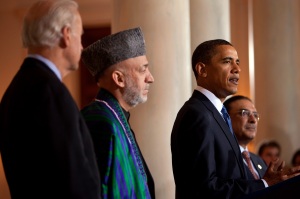 The only thing worse than a nuclear terrorist attack on US soil may in fact be more likely.
The only thing worse than a nuclear terrorist attack on US soil may in fact be more likely.
Nuclear terrorism is one of the few issues that almost everyone can agree on – it really is a worst case scenario. A terrorist organization acquiring unsecure nuclear material from a nuclear state – or worse, purchasing nuclear technology off the nuclear black market – is the ultimate unthinkable tragedy and a very difficult enemy. Commensurate retaliation on the attackers would be impossible. The US might choose to retaliate against the nation that supplied the nuclear material or weapon; or against the nation hosting the terrorist organization, but such actions are ultimately ineffective at limiting a future threat.
Consider this scenario: al Qaeda acquires two loose nuclear weapons through sympathetic terrorist organizations in Russia. Al Qaeda then sends its operatives along with the weapons to the port in Los Angeles and to the Boston harbor. Even a dirty bomb (one that merely disperses nuclear material rather than creating a nuclear blast) could kill hundreds of people initially and thousands more from radiation poisoning. But the true terror is from the after effects.
Markets would crash, the port of LA would close – reducing US imports by 45 percent – the current administration’s security policies would be disparaged, and we would be forced to embark on even larger counterterrorism campaign. This is all, of course, in addition to the psychological effect on the American public, the heightened security measures by nations across the globe, and the looming question of whether or not there would be another attack.
But this scenario may, in fact, be a better than at least one alternative.
Imagine again that al Qaeda has acquired two nuclear weapons. It does not have confidence in its ability to bring the weapon on to US soil, so it follows a different path – it detonates one bomb in a remote region of Southern Afghanistan. Nuclear forensics across the globe detect the blast and confirm that it is a nuclear weapon. Relatively few people are thought to be affected, but three hours later a video is released on the internet showing a senior al Qaeda leader positioned next to the second nuclear device. “There are more.” He says. “And you will bow to our demands.”
What would the world do? Certainly the US publicly claims not to negotiate with terrorists, but its own history and that of its allies suggests that negotiating with terrorists may not be too far from the norm. For example, the British did it in Northern Ireland and (depending on semantics) the US did it in Iraq and during the Iran Contra affair, among others. It is true that these “terrorist” organizations were very different from al Qaeda, but the point is the same. And we know from Spain’s example in 2004 that terrorist threats and attacks can and do influence political decisions and the democratic process.
Could the US be forced to withdraw prematurely from Iraq or Afghanistan? Close its embassies in Muslim nations?
Depending on the demands, it may not be up to the US to decide whether or not to negotiate. If the demands were to immediately withdraw all troops from Pakistan or the bomb would be detonated in Islamabad, one can be nearly certain that the either the government or the population of Pakistan would quickly drive US forces out.
So where does that leave us? Not detonating a nuclear device is at least as easy as detonating one. And that means that this even-worse case scenario is more probable. A nuclear attack leaves the US with thousands of dead civilians, a terrified population, but an emboldened sense of determination. Being held at nuclear gun-point leaves the US and its allies mostly crippled – certainly privately, if not publicly –with a terrorist organization effectively dictating foreign policy and still with the possibility of a devastating nuclear attack.
In that situation, what could we do?








